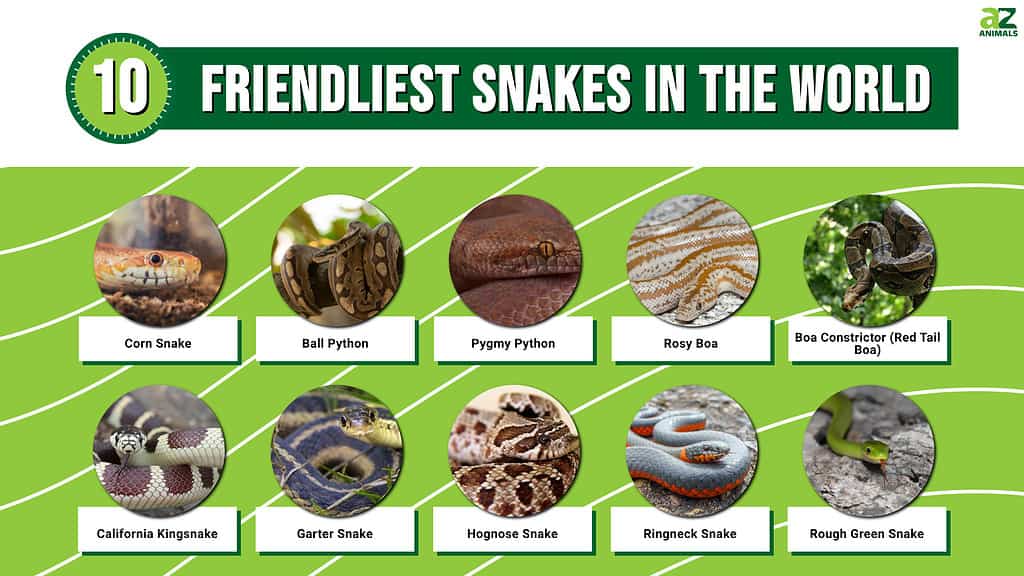
I love hugging my friend’s big fluffy Bernese mountain dog, but a snake? I’m not so sure. I know there are a few snakes that I would not want to hug, like a massive boa constrictor. But boa constrictors are actually one of the most popular pet snakes, so maybe they are friendlier than you think. Some big-eyed smiley snakes do score points for cuteness, and others are not venomous. One plays dead when it gets frightened! Let’s find out about the ten friendliest snakes in the world!
10. Rough Green Snake

Look at this happy snake! Rough green snakes are one of the friendliest snakes because they look like they are always smiling.
©iStock.com/Shoemcfly
On the cuteness scale, these get a 10! Rough green snakes are small bright green snakes that look like they are always smiling! Their big black eyes give them a cartoonish look. They are slender snakes (about the width of your finger) and average 10-20 inches. They are shy, timid snakes that are not aggressive, but they also seem not to enjoy being handled. As a pet, they are recommended for experienced snake owners or as a snake to watch vs handle. Smooth green snakes are a very similar cousin.
9. Ringneck Snake
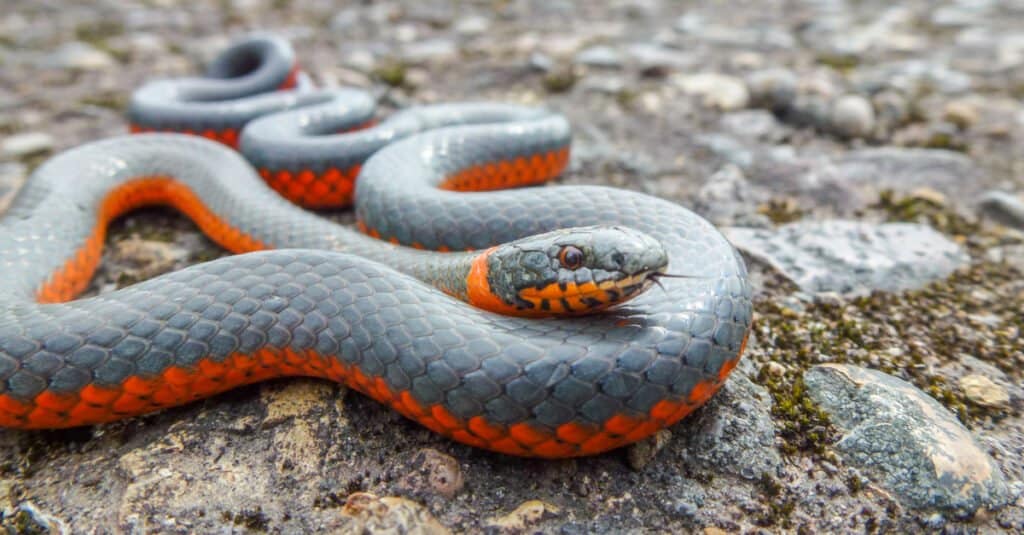
Ringneck Snakes are small snakes that look like they have a collar. Adult Ringneck snakes grow to be about a foot-and-a-half.
©Tom Fenske/Shutterstock.com
Not big enough to hug, but as one of the smallest snakes on the list, it scores big points for cuteness. Ringneck snakes are tiny and only get to be about a foot to a foot-and-a-half. They can curl up in your hand. They are so small. Native to the United States, you could find one in the wild, but they are nocturnal and only come out at night. They get their name from the orange ring around their neck that looks like a cute collar. Their bodies are typically all grayish-black on top with a yellowish-orange belly. They do lose some points on the friendliness scale because they are mildly venomous, but the venom isn’t harmful to humans.
8. Hognose Snake
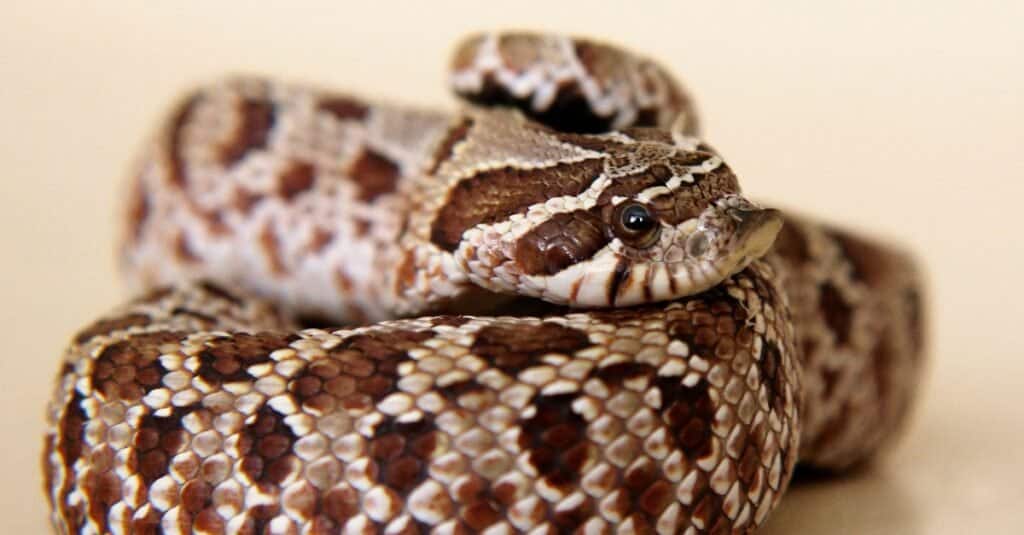
The hognose snake is a friendly snake that has a cute turned-up nose. They are also not aggressive. In fact, if they are threatened, they play dead!
©iStock.com/Iuliia Morozova
Bulldogs have a turned-up nose, and so do these friendly snakes. The hognose snake uses its nose as a shovel to dig through the dirt. Hognose snakes are heavier-bodied snakes that only get to be 25-30 inches. They are blackish with dark brown markings. They produce a small amount of venom used to subdue their prey, but it’s not dangerous to people. Additionally, if they feel threatened, they will initially act like a cobra and hiss and lunge but not bite. If that doesn’t work, they play dead, and in a super dramatic way, they roll on their backs, writhe around a bit, and then freeze with their mouth open and tongues hanging out. Now that is Oscar material!
7. Garter Snake
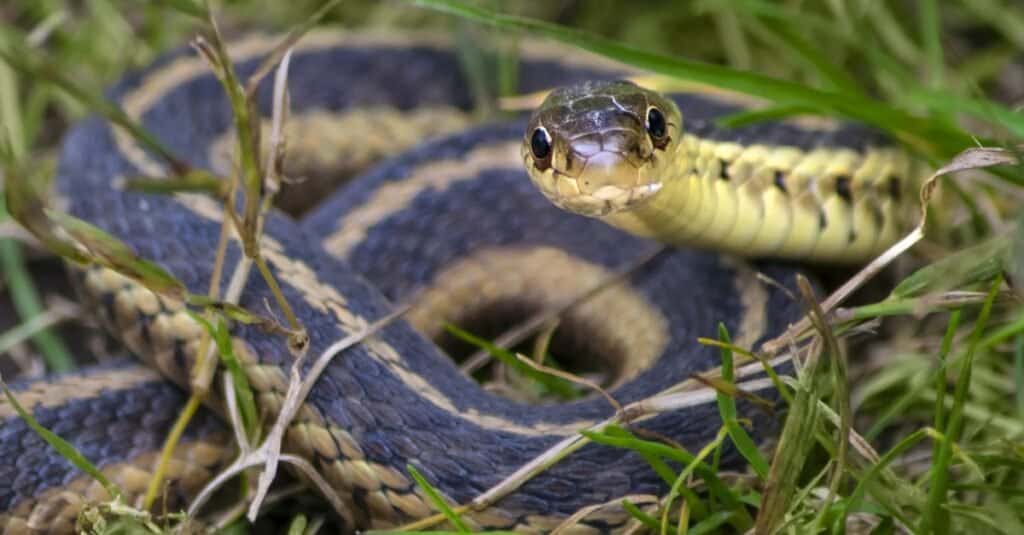
Garter snakes are a very common snake in the United States. They don’t mind being handled and make good pets.
©K Quinn Ferris/Shutterstock.com
These are one of the most common snakes in North America. Garter snakes are super friendly snakes and are recommended as a great pet because they are easy to handle. Although wild garter snakes may release a foul smell if handled, captive-bred ones are easier to handle and can be tamed if handled regularly. They have longitudinal stripes that go the length of their bodies and are a variety of colorations. Garter snakes are small to medium-sized snakes that can get to be 2-3 feet long. PetMD says they make a great starter snake for families with children.
6. California Kingsnake
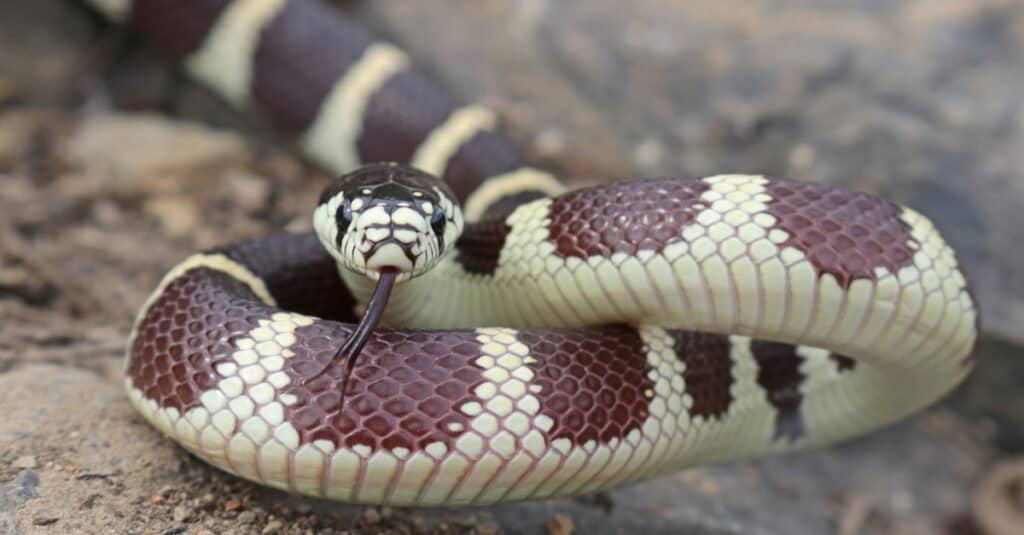
California kingsnakes have a calm temperament and grow to be 3-5 feet long.
©Creeping Things/Shutterstock.com
The California kingsnake is one of the friendliest snakes because it is mild-mannered and good with kids! It is one of the top 5 recommended pet snakes for first-time snake owners. They have a calm temperament and are easily tamed with frequent handling. California kingsnakes can get to be 3-5 feet long but can live just fine in a 20-gallon tank. They are blackish-brown with off-white bands and big black eyes.
5. Boa Constrictor (Red Tail Boa)

Red Tail Boas are constrictors but are not aggressive toward humans. They are pretty docile and captive-bred ones are a popular pet snake.
©Jan Hejda/Shutterstock.com
Did you know your next-door neighbor could have a boa constrictor? Since it is a non-venomous snake, most states allow people to own them as pets. Boas and pythons are actually popular pets for snake owners. Getting a captive-bred boa ensures that the boa will be more friendly and easily socialized. Boa constrictors are thick snakes and can get to be 6-9 feet long (and sometimes even longer). If you do own a boa, be sure to keep them in a secure enclosure, really secure. Every year there seem to be reports of “Boa Escapes, On the Loose in enter your town here.”
In Vancouver, Canada, an 8-foot boa named Cody got loose in August of 2021. The owner woke up to find it had escaped and was not anywhere in the house. She let the police know, and they put out a notice for people to be on the lookout. Luckily, Cody made his way back home without incident. Even if they are friendly, I would not want to run into one while out walking my dog!
4. Rosy Boa
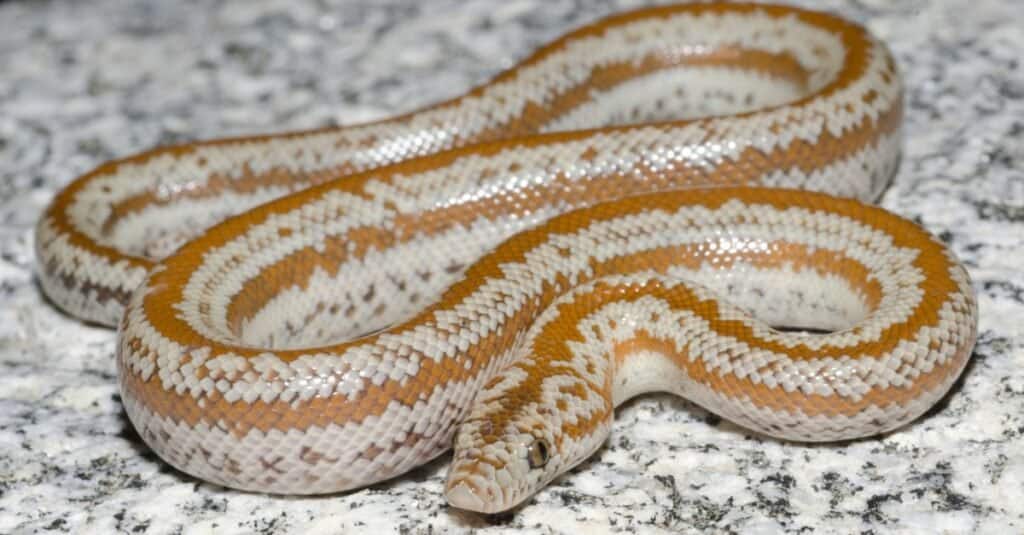
Rosy boas are found in the United States in parts of California and Arizona. Although they are constrictors they only get to be 3 feet long.
©Jason Mintzer/Shutterstock.com
Another friendly boa constrictor is the rosy boa. If a 6 to 9-foot snake sounds intimidating, then maybe a Rosy Boa is a better option. Rosy Boas are much smaller and only get to be 3 feet long. They have a unique coloration with a ton of variation, but many are light-colored, almost white, with three skinny stripes that go down their body lengthwise. The stripes are a rose or salmon color. Rosy Boas are docile and easy to handle. They do live in the United States in the southwestern states of California and Arizona. If you want one as a pet is best to get one that is captive-bred to ensure ease of socialization.
3. Pygmy Python
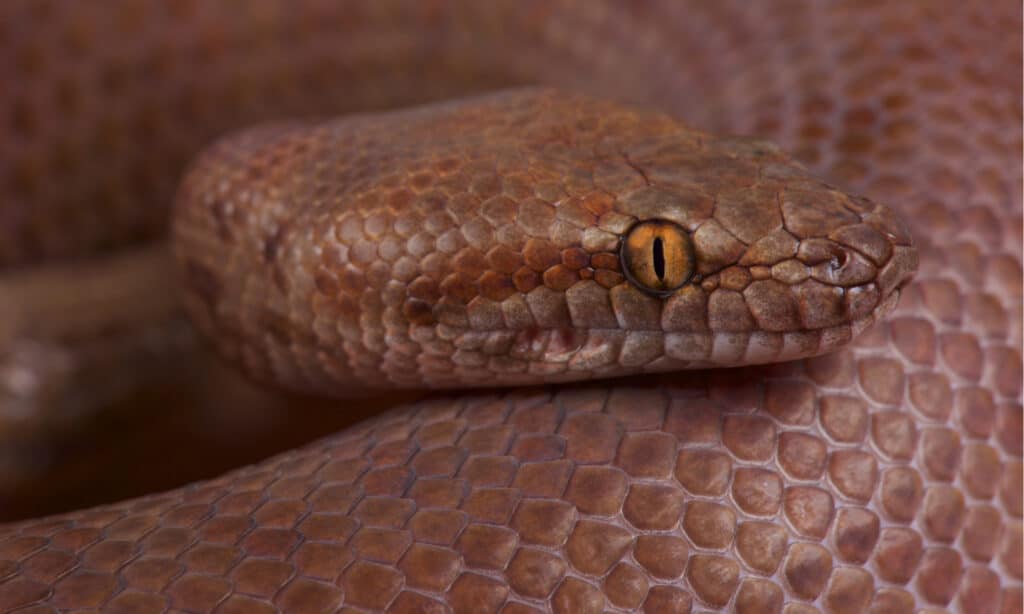
©reptiles4all/Shutterstock.com
Another constrictor snake is the python. A friendly little python is a pygmy python, the smallest python in the world. They are docile snakes from northwest Australia. When they hatch, they are only 6 inches long and thin, small enough to fit in your hand. As adults, they typically don’t get longer than 2 feet. Most are brick red with faint criss-cross markings. Large pythons can eat rats, pigs, and monkeys and can even consume an entire deer. What can a small Pygmy Python constrict? In Australia, they will wait outside the entrance to caves and snatch bats as they fly in and out. Clever hunting technique!
They do have a curious, friendly nature but need gentle handling and patience. Socialization of a pygmy python can take from mere weeks up to a year. They also have voracious appetites and can put on too much weight if overfed. Finding a breeder for them can be difficult as Australia has been closed to exporting animals for a long time.
2. Ball Python

Ball pythons are the most popular pet snake. They are thick-bodied constrictors that can grow to be 5 feet long.
©BikerPhoto/Shutterstock.com
The ball python is the most popular pet snake. It is a larger constrictor snake that is tan with dark brown markings. Adult ball pythons can get to be 5 feet long. They are not venomous but are constrictors. Ball pythons are legal as pets in most states, but there is a list of other python species that are not legal, including the Burmese Python. Burmese pythons are considered an invasive, destructive species in the Everglades of Florida. After a hurricane destroyed a breeding facility, hundreds escaped into the Everglades. FWC says that they are killing off many of the raccoons, opossums, and bobcats. Even though pythons can be friendly with humans, they can be destructive to a new environment, so never release one into the wild.
1. Corn Snake
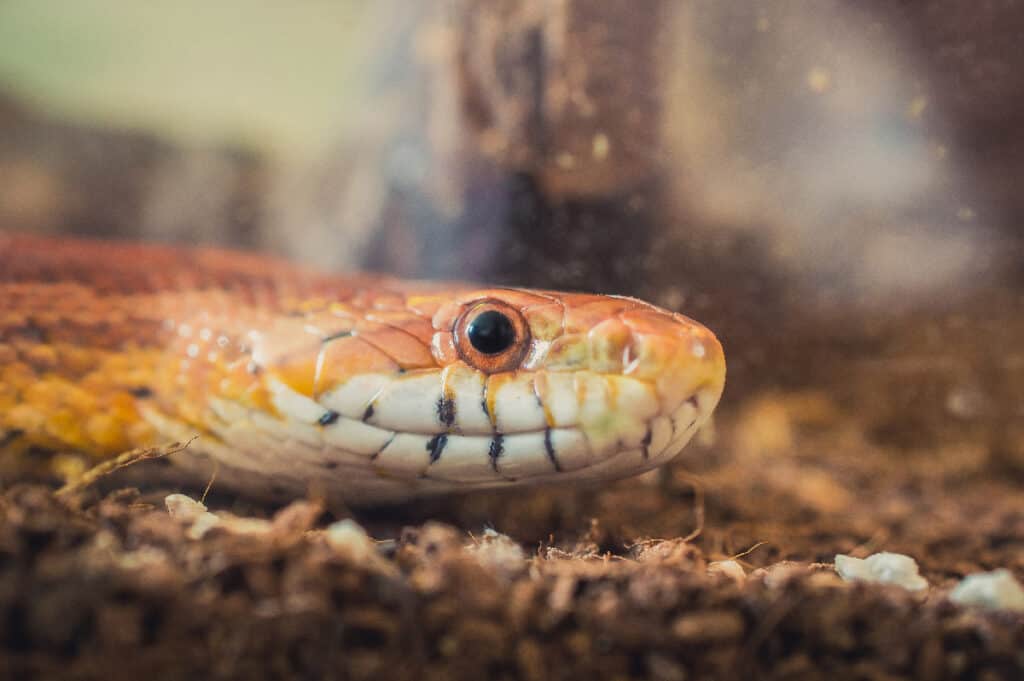
The friendliest snake in the world is the Corn Snake. They have the best personality and are popular pets!
©iStock.com/Tamascsere
The friendliest snake in the world is the corn snake. They would be voted “best personality” in the yearbook of snakes. Corn snakes are very friendly and love to be handled. Because they are easy to take care of, they are one of the most popular pet snakes. With a mix of reddish and orangish markings on a light background, they have scales that look beaded, making it look like maize or corn kernels (thus the name corn snake). These snakes can get to be 4-6 feet long as adults. When it comes to the cute factor, search “corn snakes in hats” to entertain yourself with photo after photo of cute snakes in top hats, cowboy hats, sombreros, and more!
Fun Fact!
A snake breeder in Georgia accidentally bred a Python that has a design on its back that looks like three smiley emojis. Justin Kobylka has been breeding snakes for years and didn’t quite expect this extremely rare outcome. The snake is a lavender albino piebald ball python and it turned out to be all white with yellow markings on its back and head. Three of the markings look just like smiley faces. Now that is one of the friendliest snakes in the world!
Summary Of The 10 Friendliest Snakes In The World
Here’s a recap of what we consider to be the 10 most charming snakes:
| Rank | Snake | Traits |
|---|---|---|
| 1 | Corn Snake | Friendly/easy to handle/4-6ft long |
| 2 | Ball Python | Most popular among pets/5 ft long/constrictor |
| 3 | Pygmy Python | Curious & friendly when tamed over time/brick red color/2 ft long |
| 4 | Rosy Boa | Easy to handle/docile/6-9 ft long/best if captive-bred |
| 5 | Boa Constrictor (Red Tail Boa) | Easily socialized if captive-bred/6-9 ft long/keep in secure enclosure to prevent escape |
| 6 | California Kingsnake | Calm temperament/great with kids/3-5 ft long |
| 7 | Garter Snake | Very friendly/great starter snake/popular pet/3-5 ft long |
| 8 | Hognose Snake | Friendly but can be shy/plays dead and other curious behavior/25-30 inches long |
| 9 | Ringneck Snake | Tiny snake/can curl up in palm of hand/venomous but not toxic to humans/1-1.5 ft long |
| 10 | Rough Green Snake | Shy & timid/non-aggressive/best for experienced handlers or to watch/10-20 inches long |
Other Dangerous Animals Found In The World
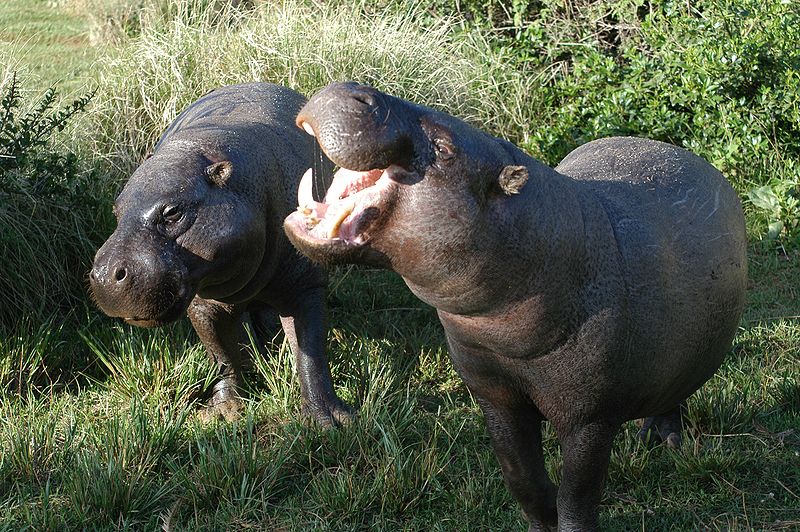
Pygmy Hippopotamus
is thought to be less aggressive than their larger counterparts.
©Chuckupd – Public Domain – License
Even though some may appear to be cute, most notably the pygmy species, one of the most dangerous animals in the world is the hippopotamus. One of the largest animals, the hippo is known for its incredible aggression. The pygmy species, although smaller, can be equally aggressive. Extremely territorial mammals, they are considered the deadliest large mammal on the planet, with an estimated 500 attacks on people each year in Africa.
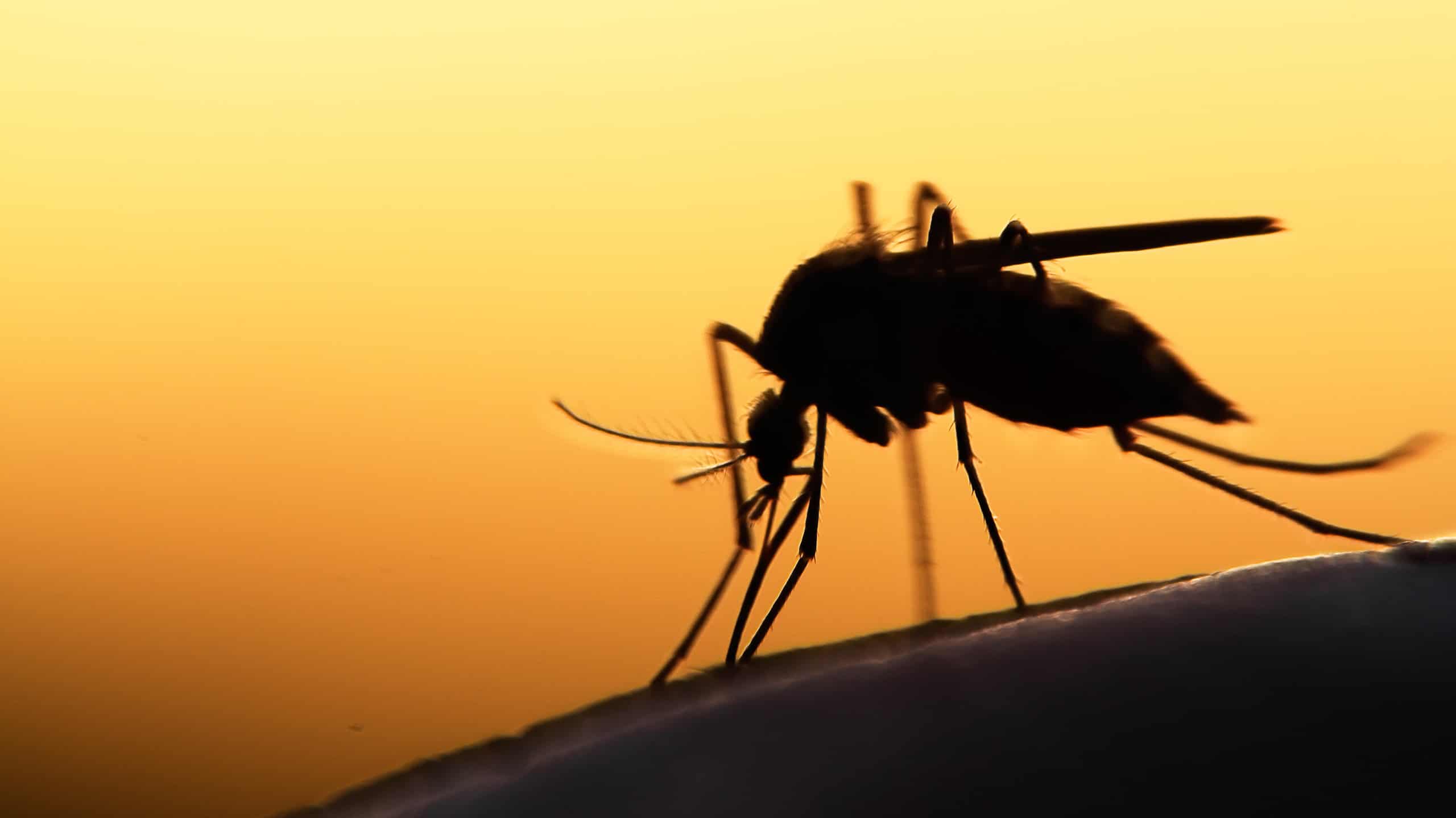
Mosquitos are responsible for the most deaths per year.
©mycteria/Shutterstock.com
Tiny but mighty, the mosquito is considered the deadliest animal in the world. According to the World Health Organization, this insect is responsible for the most deaths per year, one million. These deaths are caused by diseases like West Nile Virus, Malaria, and Dengue fever, which are spread by mosquito bites.
The photo featured at the top of this post is © iStock.com/bugphai
Discover the "Monster" Snake 5X Bigger than an Anaconda
Every day A-Z Animals sends out some of the most incredible facts in the world from our free newsletter. Want to discover the 10 most beautiful snakes in the world, a "snake island" where you're never more than 3 feet from danger, or a "monster" snake 5X larger than an anaconda? Then sign up right now and you'll start receiving our daily newsletter absolutely free.
Thank you for reading! Have some feedback for us? Contact the AZ Animals editorial team.






